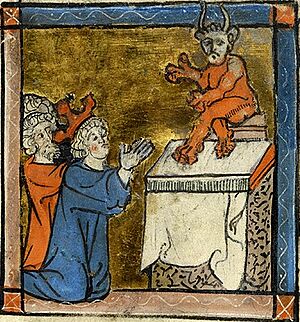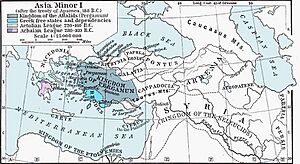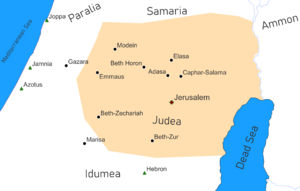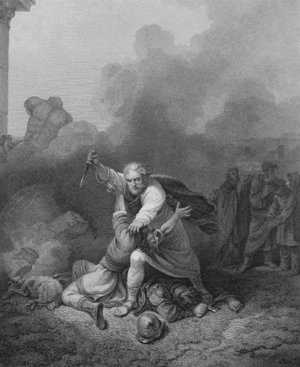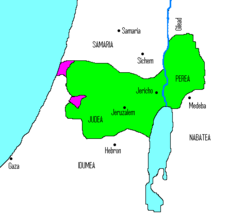Maccabean Revolt facts for kids
Quick facts for kids Maccabean Revolt |
|||||||
|---|---|---|---|---|---|---|---|
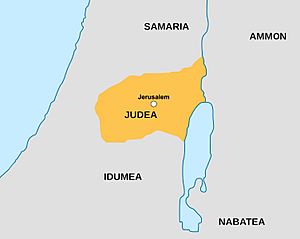 Jerusalem and Judea during the revolt |
|||||||
|
|||||||
| Belligerents | |||||||
| Maccabees | Seleucid Empire | ||||||
| Commanders and leaders | |||||||
| Mattathias # Judas Maccabeus † Jonathan Apphus Eleazar Avaran † Simon Thassi John Gaddi † |
Antiochus IV Epiphanes † Antiochus V Eupator Demetrius I Soter † Lysias Gorgias Nicanor † Bacchides |
||||||
| Units involved | |||||||
| Judean rebels | Seleucid army | ||||||
The Maccabean Revolt was a famous rebellion by Jewish fighters called the Maccabees. They fought against the Seleucid Empire to protect their religion and gain independence. The main fighting happened between 167 and 160 BCE.
The revolt is very important in history because the Maccabees captured the city of Jerusalem. They cleaned and fixed the Second Temple, which had been treated badly by the foreign rulers. This event is celebrated today during the festival of Hanukkah. Eventually, the revolt led to the creation of an independent Jewish kingdom.
Contents
Background to the conflict
Long before the revolt, Alexander the Great conquered the region of Judea. After he died, his empire was divided. A Greek kingdom called the Seleucid Empire took control of the land.
For many years, the Jewish people and the Greeks lived together peacefully. Many Jewish people learned the Greek language and adopted some Greek customs. This mixture of cultures was called Hellenism.
However, things changed when King Antiochus IV Epiphanes became the ruler. In 168 BCE, he decided to ban the Jewish religion. He made strict laws that stopped people from following their traditions. He even placed statues of Greek gods inside the holy Second Temple in Jerusalem. This made the Jewish people very angry and sad.
The rebellion begins
Mattathias and his sons
The fighting started in a town called Modein. In 167 BCE, a Greek official ordered a Jewish priest named Mattathias to offer sacrifices to Greek gods. Mattathias refused to disobey his own religion. He and his five sons fought back against the officials.
Mattathias and his family fled to the nearby mountains. They were joined by other people who wanted to protect their traditions and freedom.
Judas Maccabeus takes command
Mattathias died about a year later. His son, Judas Maccabeus, became the new leader of the rebels. His nickname "Maccabee" is thought to mean "The Hammer."
Judas was a smart commander. His army was small compared to the Greek forces, so he used guerrilla warfare. This means they used surprise attacks, moved quickly, and used the hills to hide. They won several important victories against the Seleucid armies.
The miracle of Hanukkah
In 164 BCE, the Maccabees won a huge victory and captured Jerusalem. They went to the Temple and removed the Greek statues. They built a new altar and lit the lamps to rededicate the Temple to God.
This event is the origin of the holiday Hanukkah. It is said that they only had enough oil for one day, but the lamps stayed lit for eight days.
The war continues
Battles and elephants
Even though the Maccabees controlled the Temple, the war was not over. The Seleucid Empire sent larger armies to fight the rebels. These armies were very strong and even included war elephants.
In one famous battle, Judas's brother Eleazar Avaran attacked a war elephant because he thought the enemy king was riding it. Eleazar was killed, but his bravery became a famous story.
Death of Judas
The fighting continued for several years. In 160 BCE, a large Greek army led by General Bacchides came to Judea. Judas Maccabeus faced them at the Battle of Elasa. Sadly, Judas was killed in the fight, and his army had to retreat.
Independence for Judea
Jonathan and Simon
After Judas died, his brothers Jonathan Apphus and Simon Thassi took charge. They were clever leaders who used both fighting and diplomacy.
The Seleucid Empire began to have its own internal problems, with different leaders fighting to be the king. Jonathan and Simon used this confusion to their advantage. They made deals with the different Greek leaders to get more freedom for their people.
A new kingdom
By 141 BCE, Simon Thassi drove the last Greek soldiers out of Jerusalem. The Jewish people declared him their leader and High Priest. This marked the beginning of the Hasmonean dynasty, an independent Jewish kingdom. They also made an alliance with the Roman Republic to help protect their new independence.
How they fought
The two sides fought very differently:
- The Seleucids had professional soldiers. They used a formation called a phalanx, where soldiers stood close together with long spears called pikes. They also had cavalry (soldiers on horses) and elephants.
- The Maccabees started as irregular fighters. They knew the hills and mountains well. They used slings, bows, and swords. Later, as they became stronger, they formed a proper army with better equipment.
Why it matters today
The Maccabean Revolt is a very important event in history.
- Hanukkah: The story of the victory and the Temple is told every year during this holiday.
- Independence: It showed that a small group could stand up to a big empire to protect their beliefs.
- History: The story is written in ancient books called 1 Maccabees and 2 Maccabees.
Images for kids
See also
 In Spanish: Revuelta de los macabeos para niños
In Spanish: Revuelta de los macabeos para niños
- Jewish military history
- Second Temple period
- Hasmonean dynasty


